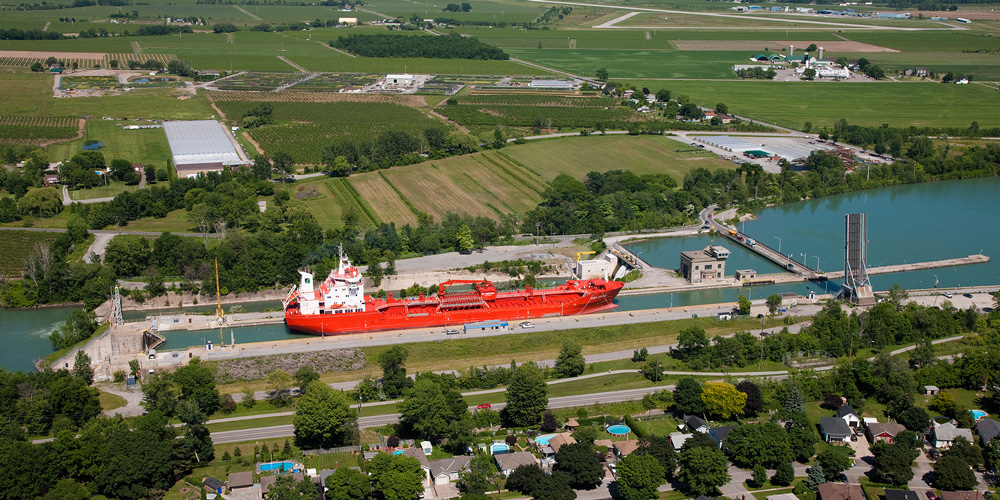Seaway Begins 60th Navigation Season
March 29, 2018
Modernization Program Brings About Greatest Advancements in Operations Since 1959
St. Catharines, Ontario (March 29, 2018) – The St. Lawrence Seaway Management Corporation marked the opening of the Seaway’s 60th navigation season today, with the transit of the newly built Algoma Niagara through Lock 3 on the Welland Canal. State-of-the-art ships such as the Algoma Niagara serve as a key part of the supply chain serving to bolster the competitiveness of North American industry. Over 227,000 jobs are supported by cargo moving over the Great Lakes / Seaway System.
Terence Bowles, President and CEO of The St. Lawrence Seaway Management Corporation (SLSMC), noted in his opening address that 2018 marked both the 60th navigation season for the waterway and the 20th anniversary of the SLSMC. Created in 1998 as a not-for-profit corporation, the SLSMC succeeded the former St. Lawrence Seaway Authority.
“We are very pleased to celebrate 20 years of progress” said Terence Bowles. “Since 1998, the SLSMC has worked collectively with its partners to reinforce the Seaway’s competitiveness as a vital transportation artery. From being the first inland waterway in North America to implement AIS in 2003 which enables the precise monitoring of ship locations by satellite, to the recent completion of our Hands-Free Mooring system which was recognized by the OECD as a great example of innovation, the SLSMC has been at the forefront of progress within the marine industry. Our modernization program, including Hands-Free Mooring, brings about the greatest advancements in Seaway operations since its inception 60 years ago.”
The SLSMC has also invested over $1 billion in asset maintenance, renewing many parts of the infrastructure that date back to 1959 in the Montreal-Lake Ontario section, and back to 1932 in the Welland Canal section. Some of the most dramatic changes have taken place within the Welland Canal, including a series of tie-ups walls that were recently rebuilt, representing an investment of $100 million. “Our steadfast commitment to maintenance and asset renewal enables the St. Lawrence Seaway to uphold its excellent record of system reliability, consistently registering above 99% year-after-year” said Terence Bowles.
Craig H. Middlebrook, Deputy Administrator of the U.S. Saint Lawrence Seaway Development Corporation, congratulated the SLSMC on its anniversary. “The close collaboration between the two Seaway corporations has been a model of binational cooperation,” noted Mr. Middlebrook. “For the past twenty years, we have been fortunate to work with exceptional leaders and partners at the SLSMC, beginning with Guy Veronneau, his successor Dick Corfe, and presently, Terence Bowles. We look forward to continuing to build on the tremendous progress we have made together for our two countries and for the Great Lakes St. Lawrence Seaway region.”
The Algoma Niagara is part of a multi-billion dollar fleet renewal program undertaken by shipowners who frequent the St. Lawrence Seaway, underlining the industry’s strong degree of confidence in the future of the waterway. As the most energy efficient means of moving cargo with the lowest carbon footprint, these newly built ships play an important role in supporting both economic growth and enhanced trade in a highly sustainable manner.
The Seaway’s modernization program coupled with the marine industry’s fleet renewal positions the waterway as a highly competitive transportation system. “As we enter the 60th navigation season, the Seaway has the capacity to double its current tonnage within its existing locks and channels” said Terence Bowles. “The stage has been set for a St. Lawrence Seaway that will effectively serve its stakeholders for decades to come, with strong advancements in efficiency, safety, and flexibility to respond to varying market conditions.”
Quick Facts:
- The Great Lakes St. Lawrence Seaway System is a “marine highway” that extends some 3,700 km from the Atlantic Ocean to the Great Lakes. Approximately 160 million tonnes of cargo travels over the System on an annual basis, supporting over 227,000 jobs and $35 billion in economic activity (Source: Martin Economic Impact Study).
- The binational St. Lawrence Seaway serves as the linchpin within the broader waterway, connecting the lower St. Lawrence River to the Great Lakes. Beginning in Montreal and extending to points west, the Seaway’s 15 locks (13 Canadian and 2 U.S.) enable ships to climb a total of 168 metres from “sea level” up to Lake Erie. For more information on the St. Lawrence Seaway, please consult www.greatlakes-seaway.com.
- Stakeholders within the System have been pioneers at advancing and developing new technologies that promote safety and environmental protection, including:
- In 2003, the St. Lawrence Seaway was the first inland waterway in North America to adopt the Automatic Identification System (AIS) to share vital marine navigation data from ship-to-ship and ship-to-shore in real time.
- Since 2010, Canadian shipowners have invested over $2 billion on specially-designed, eco-friendly vessels built for use in the Seaway that have won numerous international awards.
- In 2012, the St. Lawrence Seaway introduced the use of the Draft Information System, which combines satellite-based location data and highly accurate hydrographic maps to model a ship’s under-keel-clearance in 3D, allowing vessels to safely transit the Seaway with an additional three inches of draft (allowing for up to 400 tonnes of additional cargo to be loaded).
- In 2015, The St. Lawrence Seaway Management Corporation received the Promising Innovation in Transport Award by the Organization for Economic Cooperation and Development (OECD) for developing the first hands-free mooring system in the world for a lock system.
About The St. Lawrence Seaway Management Corporation:
- The St. Lawrence Seaway Management Corporation was established in 1998 as a not-for-profit corporation by the Government of Canada, Seaway users and other key stakeholders. In accordance with provisions of the Canada Marine Act, the Corporation manages and operates the Canadian assets of the St. Lawrence Seaway, which remain the property of the Government of Canada, under a long-term agreement with Transport Canada.






